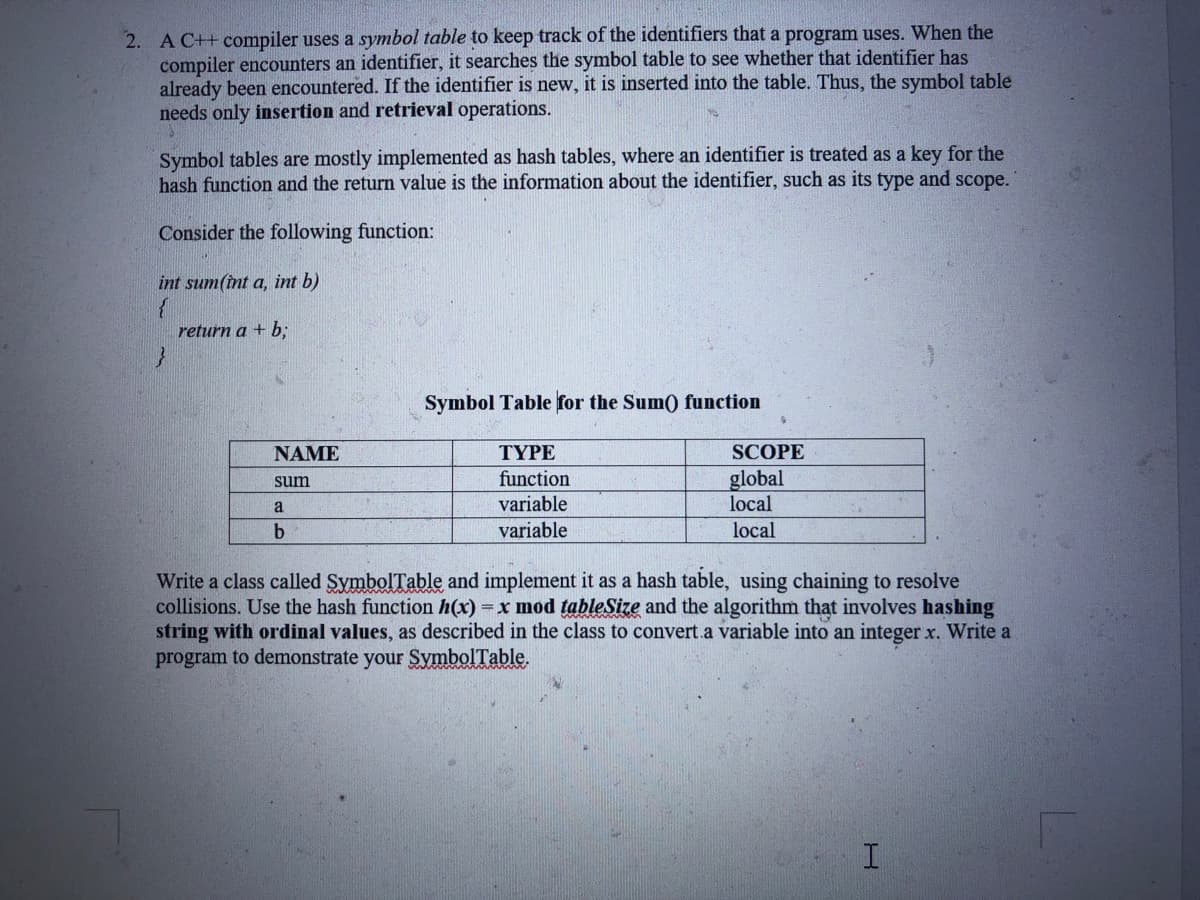2. A C++ compiler uses a symbol table to keep track of the identifiers that a program uses. When the compiler encounters an identifier, it searches the symbol table to see whether that identifier has already been encountered. If the identifier is new, it is inserted into the table. Thus, the symbol table needs only insertion and retrieval operations. Symbol tables are mostly implemented as hash tables, where an identifier is treated as a key for the hash function and the return value is the information about the identifier, such as its type and scope. Consider the following function: int sum(int a, int b) return a + b; Symbol Table for the Sum) function NAME TYPE SCOPE function global local sum a variable variable local Write a class called SymbolTable and implement it as a hash table, using chaining to resolve collisions. Use the hash function h(x) =x mod tableSize and the algorithm that involves hashing string with ordinal values, as described in the class to convert a variable into an integer x. Write a program to demonstrate your SymbolTable. %3D
2. A C++ compiler uses a symbol table to keep track of the identifiers that a program uses. When the compiler encounters an identifier, it searches the symbol table to see whether that identifier has already been encountered. If the identifier is new, it is inserted into the table. Thus, the symbol table needs only insertion and retrieval operations. Symbol tables are mostly implemented as hash tables, where an identifier is treated as a key for the hash function and the return value is the information about the identifier, such as its type and scope. Consider the following function: int sum(int a, int b) return a + b; Symbol Table for the Sum) function NAME TYPE SCOPE function global local sum a variable variable local Write a class called SymbolTable and implement it as a hash table, using chaining to resolve collisions. Use the hash function h(x) =x mod tableSize and the algorithm that involves hashing string with ordinal values, as described in the class to convert a variable into an integer x. Write a program to demonstrate your SymbolTable. %3D
Computer Networking: A Top-Down Approach (7th Edition)
7th Edition
ISBN:9780133594140
Author:James Kurose, Keith Ross
Publisher:James Kurose, Keith Ross
Chapter1: Computer Networks And The Internet
Section: Chapter Questions
Problem R1RQ: What is the difference between a host and an end system? List several different types of end...
Related questions
Question
c++

Transcribed Image Text:2. A C++ compiler uses a symbol table to keep track of the identifiers that a program uses. When the
compiler encounters an identifier, it searches the symbol table to see whether that identifier has
already been encountered. If the identifier is new, it is inserted into the table. Thus, the symbol table
needs only insertion and retrieval operations.
Symbol tables are mostly implemented as hash tables, where an identifier is treated as a key for the
hash function and the return value is the information about the identifier, such as its type and scope.
Consider the following function:
int sum(int a, int b)
return a + b;
Symbol Table for the Sum() function
NAME
ΤΥΡΕ
SCOPE
global
local
local
sum
function
a
variable
variable
Write a class called SymbolTable and implement it as a hash table, using chaining to resolve
collisions. Use the hash function h(x) =x mod tableSize and the algorithm that involves hashing
string with ordinal values, as described in the class to convert a variable into an integer x. Write a
program to demonstrate your SymbolTable.
Expert Solution
This question has been solved!
Explore an expertly crafted, step-by-step solution for a thorough understanding of key concepts.
This is a popular solution!
Trending now
This is a popular solution!
Step by step
Solved in 3 steps with 6 images

Recommended textbooks for you

Computer Networking: A Top-Down Approach (7th Edi…
Computer Engineering
ISBN:
9780133594140
Author:
James Kurose, Keith Ross
Publisher:
PEARSON

Computer Organization and Design MIPS Edition, Fi…
Computer Engineering
ISBN:
9780124077263
Author:
David A. Patterson, John L. Hennessy
Publisher:
Elsevier Science

Network+ Guide to Networks (MindTap Course List)
Computer Engineering
ISBN:
9781337569330
Author:
Jill West, Tamara Dean, Jean Andrews
Publisher:
Cengage Learning

Computer Networking: A Top-Down Approach (7th Edi…
Computer Engineering
ISBN:
9780133594140
Author:
James Kurose, Keith Ross
Publisher:
PEARSON

Computer Organization and Design MIPS Edition, Fi…
Computer Engineering
ISBN:
9780124077263
Author:
David A. Patterson, John L. Hennessy
Publisher:
Elsevier Science

Network+ Guide to Networks (MindTap Course List)
Computer Engineering
ISBN:
9781337569330
Author:
Jill West, Tamara Dean, Jean Andrews
Publisher:
Cengage Learning

Concepts of Database Management
Computer Engineering
ISBN:
9781337093422
Author:
Joy L. Starks, Philip J. Pratt, Mary Z. Last
Publisher:
Cengage Learning

Prelude to Programming
Computer Engineering
ISBN:
9780133750423
Author:
VENIT, Stewart
Publisher:
Pearson Education

Sc Business Data Communications and Networking, T…
Computer Engineering
ISBN:
9781119368830
Author:
FITZGERALD
Publisher:
WILEY